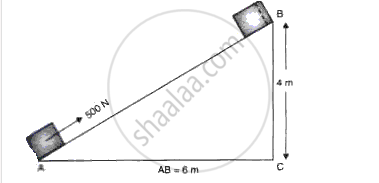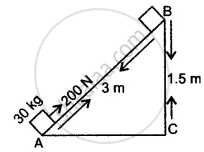Advertisements
Advertisements
प्रश्न
Define the term energy.
उत्तर १
“Capacity of doing work” is called Energy.
उत्तर २
Energy, in physics, is the capacity for doing work. It may exist in potential, kinetic, thermal, electrical, chemical, nuclear, or other various forms. There are, moreover, heat and work-i.e., energy in the process of transfer from one body to another.
संबंधित प्रश्न
Look at the activity below. Reason out whether or not work is done in the light of your understanding of the term ‘work’.
A sailboat is moving due to wind energy.
An object thrown at a certain angle to the ground moves in a curved path and falls back to the ground. The initial and the final points of the path of the object lie on the same horizontal line. What is the work done by the force of gravity on the object?
State two conditions when no work is done by a force.
State two factors on which the work done on a body depends.
In which of the following cases, is work being done?
(i) A man pushing a wall.
(ii) a coolie standing with a load of 12 kgf on his head.
(iii) A boy climbing up a staircase.
Give one example each in which a force does (a) positive work (b) negative work, and (c) zero work.
A car is being driven by a force of 2.5 ✕ 1010 N. Travelling at a constant speed of 5 m/s, it takes 2 minutes to reach a certain place. Calculate the work done.
What happens to the work done when the dispacement of body is at right angles to the direction of force acting on it? Explain your answer.
In case of negative work, the angle between the force and displacement is :
Determine the amount of work done when an object is displaced at an angle of 30° with respect to the direction of the applied force.
Choose one or more correct alternatives.
Joule is the unit of ______.
- force
- work
- power
- energy
Is work done a scalar or a vector physical quantity?
Define 'joule'.
What is the ratio of SI units to CGS units of 'work'?
On what factors does the work done by a force depend?
No work is done by a man moving on a horizontal road while carrying a box on his head. Explain.
A weight lifted a load of 200 kgf to a height of 2.5 m in 5 s. calculate: (i) the work done, and (ii) the power developed by him. Take g= 10 N kg-1.
Can work done be zero even if force acts on the body?
Define the term work. Name the CGS and SI unit of work.
A block of mass 20 kg is pulled up a slope (fig.12) with a constant speed by applying a force of 500 N parallel to the slope. A and B are initial and final positions of the block.
(a) Calculate the work done by the force in moving the block from A and B.
(b) Calculate the potential energy gained by the block.

Define energy and state the unit of energy and the law of conservation of energy.
A bullet is of mass 'm' g and is moving with a velocity 'v' m/s. Find the kinetic energy of the bullet when
(a) The mass is doubled,
(b) The velocity is tripled.
Fill in the boxe to show the corresponding energy transformation.

State the amount of work done by an object when it moves in a circular path for one complete rotation. Give a reason to justify your answer.
Name the material commonly used for the manufacturing of solar cells.
A block of mass 30 kg is pulled up a slope, as shown in diagram with a constant speed, by applying a force of 200 N parallel to slope.
A and B are initial and final positions of block.

(i) Calculate the work done by force in moving the block from A to B.
(ii) Calculate P.E. gained by block. [g=10ms-2]
The work done by the heart is 1 Joule per beat. Calculate the power of the heart if it beats 72 times in one
The weights of two bodies are 2.0 N and 2.0 kgf respectively what is the mass of each body?
A bucketful of water is to be drawn from a well ______ will be done when a ______ is applied to do this because there will be a ______ of water.
(displacement, work, force)
